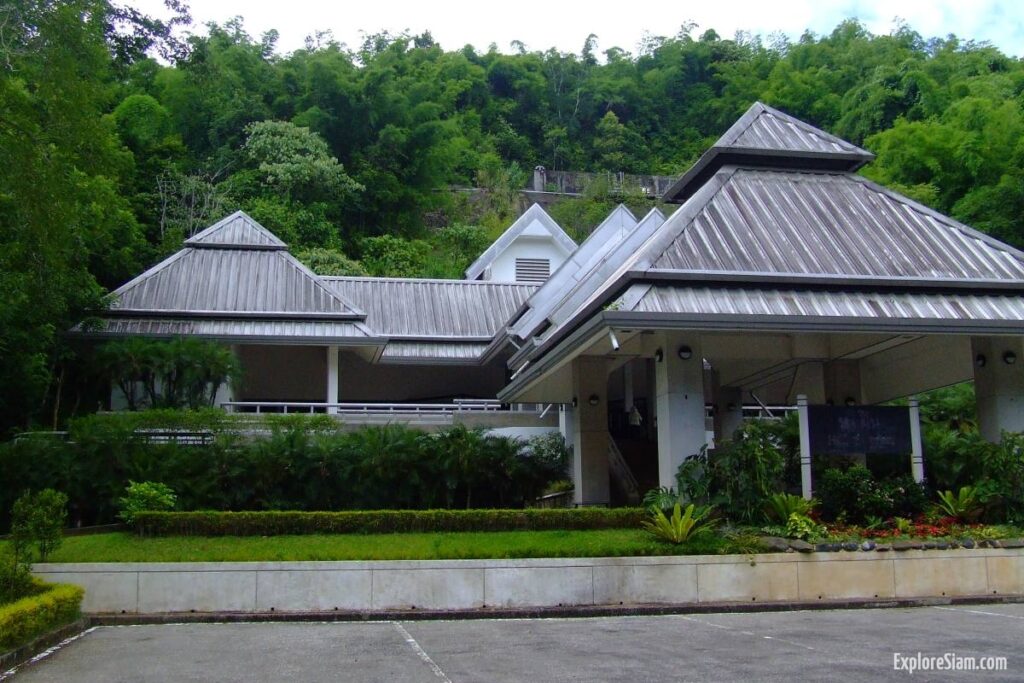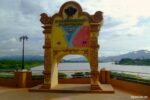Nestled in the lush, verdant landscapes of northern Thailand, the Hall of Opium in the Golden Triangle stands as a testament to the region’s complex and often tumultuous relationship with the opium trade. This fascinating museum, located in Chiang Saen, offers a profound and comprehensive exploration of the history, culture, and impact of opium, making it a must-visit for travelers seeking to understand the deeper narratives of Southeast Asia.
The Golden Triangle: A Region Shaped by Opium
The Golden Triangle, where the borders of Thailand, Laos, and Myanmar converge, has long been synonymous with the opium trade. This area has been a focal point for opium production and distribution for centuries, significantly impacting the global narcotics market. For decades, this region was one of the world’s most prolific opium-producing areas, with its remote and rugged terrain providing ideal conditions for growing opium poppies. The Hall of Opium seeks to unravel this intricate history, providing visitors with a thorough understanding of how opium shaped the region’s economy, society, and international relations. Through detailed exhibits, the museum traces the historical development of the opium trade in the Golden Triangle, illustrating the economic dependency that local communities developed on this crop and the complex relationships between local farmers, traders, and powerful warlords who controlled the trade routes.
A Comprehensive Exhibition
The Hall of Opium, established by the Mae Fah Luang Foundation, offers a meticulously curated exhibition that spans the lifecycle of opium, from its botanical origins to its transformation into a potent narcotic and its far-reaching consequences. The museum’s immersive displays and interactive exhibits engage visitors on multiple levels, blending education with experience. The exhibition is divided into several sections, each offering a unique perspective on the opium narrative. Visitors begin their journey by learning about the biological characteristics of the opium poppy and the traditional methods used to harvest its latex. The museum then delves into the history of opium use, tracing its role in ancient civilizations and its evolution into a global commodity. Detailed dioramas and multimedia presentations bring the story to life, providing a vivid portrayal of the people and events that shaped the opium trade.

The Botanical Beginnings
The journey begins with an exploration of the opium poppy, Papaver somniferum. This section of the museum is dedicated to the plant’s biology, its cultivation, and the traditional methods of extracting opium latex. Visitors are introduced to the various species of the poppy, learning about their unique characteristics and the environmental conditions required for their growth. The museum’s botanical garden showcases these plants in their natural setting, providing a serene yet informative introduction to the opium narrative. Detailed displays explain the process of extracting opium from the poppy’s seed capsules, highlighting the labor-intensive techniques used by farmers throughout history. This section also explores the traditional uses of opium in medicine and rituals, providing a historical context for its significance in various cultures.
Historical Context
The Hall of Opium delves into the historical context of opium use and trade. Exhibits trace the drug’s journey from ancient civilizations, where it was used for medicinal and ritualistic purposes, to its role in global trade networks. The museum highlights the opium wars, colonial exploitation, and the socio-political ramifications of opium on nations and empires. Visitors learn about the rise of opium dens in the 19th century, the impact of British colonial policies on the opium trade in China, and the devastating effects of addiction on communities. The museum also explores the cultural representations of opium in literature and art, providing a deeper understanding of its complex role in society. Through a combination of artifacts, historical documents, and interactive exhibits, visitors gain a comprehensive understanding of the opium trade’s historical significance and its lasting impact on global politics and economics.
The Dark Side of Opium
A significant portion of the exhibition is dedicated to the darker aspects of the opium trade. Visitors are confronted with the harsh realities of addiction, the human suffering caused by the drug, and the global fight against narcotics. The displays include personal stories, photographs, and artifacts that humanize the impact of opium, making it more than just a historical commodity. This section of the museum addresses the social and health consequences of opium addiction, highlighting the struggles of individuals and communities affected by the drug. Visitors learn about the challenges faced by those battling addiction, the stigma associated with drug use, and the efforts of healthcare providers and social workers to provide support and treatment. The museum also examines the role of international organizations and governments in combating the opium trade, showcasing the various strategies employed to reduce supply and demand, and the ongoing efforts to promote alternative livelihoods for farmers in opium-producing regions.
The Role of the Golden Triangle
The Hall of Opium provides an in-depth look at the Golden Triangle’s pivotal role in the global opium trade. The region’s geography, political instability, and economic conditions made it a hotspot for opium production and trafficking. The museum examines the interplay between local farmers, warlords, and international drug cartels, offering a nuanced perspective on the complexities of the trade. Through detailed maps and interactive displays, visitors learn about the key players and events that shaped the opium trade in the Golden Triangle. The museum highlights the influence of external factors, such as international demand for heroin and the impact of geopolitical conflicts on the region’s drug trade. By providing a comprehensive overview of the Golden Triangle’s role in the opium trade, the museum helps visitors understand the broader implications of drug trafficking and its impact on global security and development.
Contemporary Efforts and Rehabilitation
The museum does not shy away from the ongoing challenges posed by opium and its derivatives. It highlights contemporary efforts to combat drug trafficking and addiction, featuring initiatives by governments, NGOs, and local communities. The Hall of Opium also emphasizes the importance of rehabilitation and education in addressing the root causes of addiction. Visitors learn about the various approaches to drug prevention and treatment, including harm reduction strategies, community-based rehabilitation programs, and public awareness campaigns. The museum showcases success stories from around the world, illustrating the positive impact of these initiatives on individuals and communities. By highlighting the importance of a comprehensive and multi-faceted approach to addressing drug-related issues, the museum inspires visitors to consider their role in supporting efforts to combat the opium trade and promote health and well-being.
The Mae Fah Luang Foundation
The establishment of the Hall of Opium is a testament to the vision of the Mae Fah Luang Foundation, founded by the late Princess Mother of Thailand, Srinagarindra. The foundation’s mission is to improve the quality of life for people in the region through sustainable development and cultural preservation. The museum stands as a symbol of hope and progress, reflecting the foundation’s commitment to transforming the Golden Triangle from a hub of the opium trade to a beacon of positive change. Visitors learn about the foundation’s various projects, including efforts to promote alternative livelihoods for former opium farmers, support for community development initiatives, and programs to preserve the region’s cultural heritage. The museum serves as a platform for showcasing the foundation’s achievements and inspiring others to support its mission.
A Journey of Reflection and Learning
Visiting the Hall of Opium is more than just a tour; it is a journey of reflection and learning. The museum’s thoughtful curation and engaging exhibits invite visitors to contemplate the broader implications of the opium trade and its lasting impact on societies. By understanding the past, the Hall of Opium inspires a future where education and awareness can lead to a world free from the shadows of narcotics. The museum’s immersive displays and interactive exhibits encourage visitors to engage with the material on a deeper level, prompting questions and discussions about the social, economic, and political factors that have shaped the opium trade. Through its comprehensive and engaging exhibits, the museum not only informs but also inspires visitors to consider the role they can play in addressing the challenges posed by narcotics and promoting health and well-being in their communities.
Practical Information for Visitors
The Hall of Opium is located in Chiang Saen, a scenic town in Chiang Rai province. The museum is easily accessible by road, and the journey itself offers stunning views of the northern Thai landscape. The museum is open daily except for Mondays, and guided tours are available in multiple languages, providing visitors with a comprehensive understanding of the exhibits. In addition to the main exhibition, the museum offers a range of educational programs and activities for visitors of all ages. These include workshops, lectures, and special events designed to deepen visitors’ understanding of the opium trade and its impact on the region. The museum also features a gift shop and café, where visitors can purchase local crafts and enjoy refreshments while taking in the beautiful surroundings.
In conclusion, the Hall of Opium in the Golden Triangle is a powerful and enlightening destination that sheds light on one of the most significant yet often overlooked aspects of Southeast Asian history. It offers an educational and emotional experience that resonates long after the visit, making it a pivotal stop for any traveler exploring the rich tapestry of Thailand’s cultural and historical heritage. Through its comprehensive and engaging exhibits, the museum not only informs but also inspires visitors to understand and contribute to the ongoing efforts to address the global challenges posed by narcotics. Whether you are a history enthusiast, a cultural explorer, or simply a curious traveler, a visit to the Hall of Opium is an opportunity to gain a deeper understanding of the complexities of the opium trade and its lasting impact on the world.





